
A mammoth is any species of the extinct elephantid genus Mammuthus. They lived from the late Miocene epoch into the Holocene about 4,000 years ago, and various species existed in Africa, Europe, Asia, and North America. Mammoths are distinguished from living elephants by their spirally twisted tusks and in at least some later species, the development of numerous adaptions to living in cold environments, including a thick layer of fur.

Proboscidea is a taxonomic order of afrotherian mammals containing one living family (Elephantidae) and several extinct families. First described by J. Illiger in 1811, it encompasses the elephants and their close relatives. Three species of elephant are currently recognised: the African bush elephant, the African forest elephant, and the Asian elephant.

A mastodon is a member of the genus Mammut, which strictly defined, was endemic to North America and lived from the late Miocene to the early Holocene. Mastodons belong to the order Proboscidea, the same order as elephants and mammoths. Mammut is the type genus of the extinct family Mammutidae, which diverged from the ancestors of modern elephants at least 27-25 million years ago, during the Oligocene.
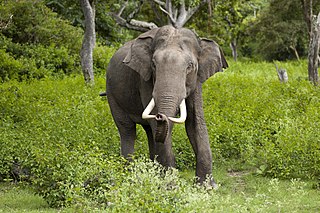
Elephantidae is a family of large, herbivorous proboscidean mammals collectively called elephants and mammoths. These are large terrestrial mammals with a snout modified into a trunk and teeth modified into tusks. Most genera and species in the family are extinct. Only two genera, Loxodonta and Elephas, are living.

Mammutidae is an extinct family of proboscideans belonging to Elephantimorpha. It is best known for the mastodons, which inhabited North America from the Late Miocene until their extinction at beginning of the Holocene, around 11,000 years ago. The earliest fossils of the group are known from the Late Oligocene of Africa, around 24 million years ago, and fossils of the group have also been found across Eurasia. The name "mastodon" derives from Greek, μαστός "nipple" and ὀδούς "tooth", referring to their characteristic teeth.

Moeritherium is an extinct genus of primitive proboscideans. These prehistoric mammals are related to the elephant and, more distantly, sea cows and hyraxes. They lived during the Eocene epoch.
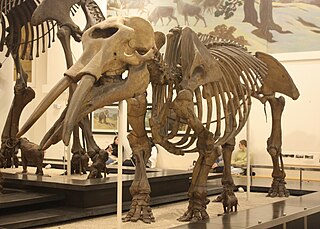
Gomphotheres are an extinct group of proboscideans related to modern elephants. They were widespread across Afro-Eurasia and North America during the Miocene and Pliocene epochs and dispersed into South America during the Pleistocene as part of the Great American Interchange. Gomphotheres are a paraphyletic group that is ancestral to Elephantidae, which contains modern elephants, as well as Stegodontidae. While most famous forms such as Gomphotherium had long lower jaws with tusks, which is the ancestral condition for the group, some later members developed shortened (brevirostrine) lower jaws with either vestigial or no lower tusks, looking very similar to modern elephants, an example of parallel evolution, which outlasted the long-jawed gomphotheres. By the end of the Early Pleistocene, gomphotheres became extinct in Afro-Eurasia, with the last two genera, Cuvieronius ranging from southern North America to western South America, and Notiomastodon having a wide range over most of South America until the end of the Pleistocene around 12,000 years ago, when they became extinct following the arrival of humans.
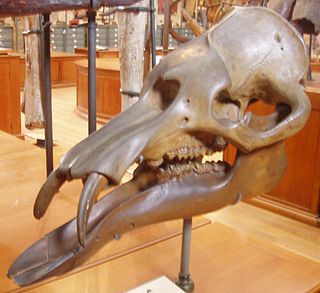
Phiomia is an extinct genus of basal elephantiform proboscidean that lived in what is now Northern Africa during the Late Eocene to Early Oligocene some 37–30 million years ago. "Phiomia serridens" means "saw-toothed animal of Faiyum".

Gomphotherium is an extinct genus of gomphothere proboscidean from the Neogene of Eurasia, Africa and North America. The genus is probably paraphyletic.

Anancus is an extinct genus of "tetralophodont gomphothere" native to Afro-Eurasia, that lived from the Tortonian stage of the late Miocene until its extinction during the Early Pleistocene, roughly from 8.5–2 million years ago.

Numidotherium is an extinct genus of early proboscideans, discovered in 1984, that lived during the middle Eocene of North Africa some 46 million years ago. It was about 90-100 cm tall at the shoulder and weighed about 250-300 kg.

Palaeomastodon is an extinct genus within the elephant order Proboscidea. Its fossils have been extracted from Oligocene strata conventionally dated to 33.9-23.03 million years old. Usually considered an ancestor or near-ancestor of elephants or mastodons as a member of Elephantiformes it lived in marshes and fluvial-deltaic environments of what is now Egypt, Ethiopia, Libya, and Saudi Arabia.

Tetralophodon is an extinct genus of "tetralophodont gomphothere" belonging to the superfamily Elephantoidea, known from the Miocene of Afro-Eurasia.

Zygolophodon is an extinct genus of mammutid proboscidean that lived during the Miocene in Africa, Eurasia, and North America.
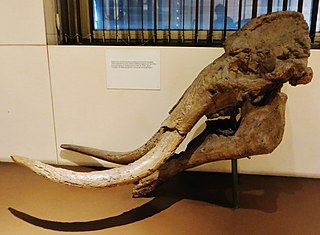
Choerolophodon is an extinct genus of proboscidean that lived during the Miocene of Eurasia and Africa. Fossils of Choerolophodon have been found in Africa, Southeast Europe, Turkey, Iraq, Iran, the Indian subcontinent, and China.

Elephantimorpha is a clade of proboscideans that contains the Mammutidae (mastodons), as well as Elephantida. All members of this group have the horizontal tooth replacement typical of modern elephants, unlike more primitive members of the Elephantiformes. Like modern elephants, the ancestor of Elephantimorpha was likely capable of communicating via infrasonic calls. While early elephantimorphs generally had lower jaws with an elongated mandibular symphysis at the front of the jaw with well developed lower tusks/incisors, from the Late Miocene onwards, many groups convergently developed brevirostrine (shortened) lower jaws with vestigial or no lower tusks, corresponding with the elongation and increasingly dexterity of the trunk allowing it to be used as the primary feeding organ.

Eozygodon is an extinct genus of proboscidean in the family Mammutidae that is based on a single species, E. morotoensis, named in 1983. It is known from the Early Miocene of Africa and well as possibly the Middle Miocene of China. It is considered a primitive member of the family, retaining a long lower jaw (longirostrine) with lower tusks. The upper tusks are small, and are parallel to each other. The skull of the young adult AM 02 from Auchas, Namibia, was around the size of that of a 10 year old American mastodon, around 60 centimetres (2.0 ft) in maximum length. Dental mesowear from East African specimens suggests a browsing diet. Some authors suggest that Eozygodon could be less closely related to other members of Mammutidae than other mammutids are to Elephantida, making Mammutidae as typically defined paraphyletic.
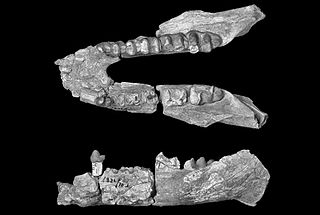
Arcanotherium is an extinct genus of early proboscidean belonging to the family Numidotheriidae that lived in north Africa during the late Eocene/early Oligocene interval.
Dagbatitherium is an extinct genus of proboscideans. So far a single molar from the phosphate basins of Togo in West Africa has been found. The fossil dates to the Middle Eocene, around 47 million years ago. A striking feature of the tooth are the three pairs of cusps oriented transversely to the longitudinal axis of the tooth. This feature is found in more derived proboscideans, which are grouped in the Elephantiformes. For its age, Dagbatitherium is the earliest member of Elephantiformes to date. Furthermore, it is characterized by a low tooth crown and a humped occlusal pattern. The genus was described in 2021.

"Mammut" borsoni is an extinct species of mammutid proboscidean known from the Late Miocene to Early Pleistocene of Eurasia, spanning from western Europe to China. It is the last known mammutid in Eurasia, and amongst the largest of all proboscideans.





















